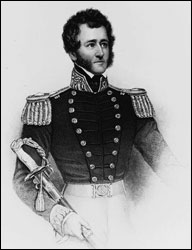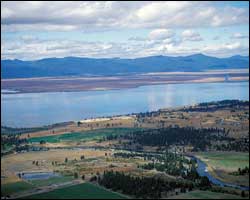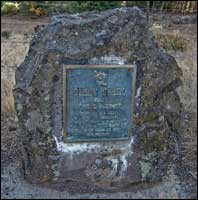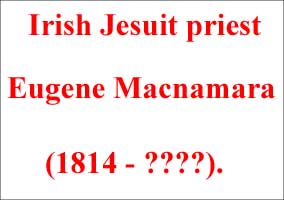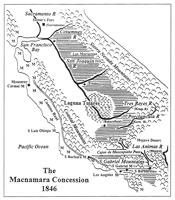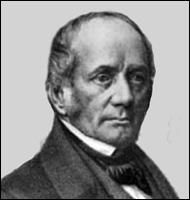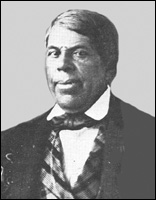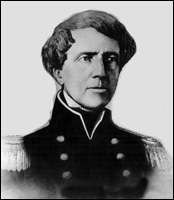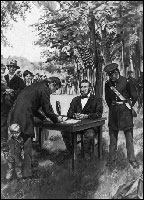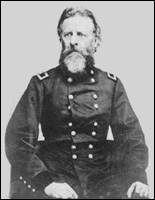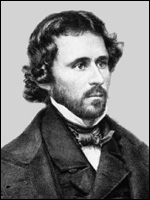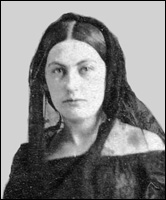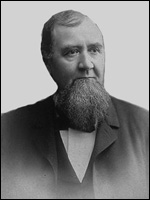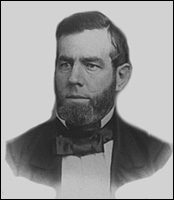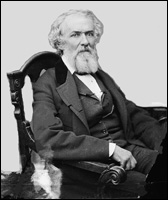BY 1845, BRITANNIA'S PLOT TO SEIZE CALIFORNIA WAS WELL UNDER WAY. MIRACULOUSLY,
JOHN C. FREMONT AND KIT CARSON ARRIVED JUST IN TIME TO RESCUE CALIFORNIA FROM THE JAWS OF LEVIATHAN (PSALM 74:14, ISAIAH 27:1). |
When Mexico declared independence from Spain in 1821 the Mexican government also claimed the vast lands of the defunct Spanish New World Empire. That included California and the present day Texas and New Mexico. Texas and New Mexico were never part of Montezuma's bloody Aztec kingdom because the land belonged to the Apaches and Comanches . . . and their braves loved to collect Mexican scalps!
 Map of the vast territory donated to Spain in the 1819 Adams-Onís Treaty. |
|
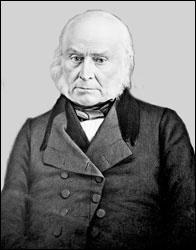 John Quincy Adams (1767–1848). Sec. of State from 1817 to 1825. |
John Quincy Adams was Secretary of State during the eight-year Presidency of James Monroe. In 1819, he negotiated a treaty with Spanish envoy Onís y Gonzáles-Vera (1762–1827).
President Jefferson believed that Texas was part of the Louisiana Purchase, so the donation of New Jerusalem territory to Spain was another corrupt bargain by Adams:
The idea that the Louisiana Purchase extended to the Rio Grande became a certainty with Jefferson early in 1804. On December 27, 1803, Claiborne and Wilkinson wrote to him that Laussat had stated that the French claims extended to the Rio Grande. Livingston was immediately informed and was instructed to obtain a copy of the Crozat charter of 1712 and any other documents that might have bearing. (Marshall, History of the Western Boundary of the Louisiana Purchase, 1819–1841, p. 13).
The Adams-Onís Treaty of 1819 fixed the northern boundary of Spanish America at 42° North latitude and the western boundary at the Pacific Ocean. The king of Spain was willing to cede Texas to the Union, but corrupt bargain John Quincy Adams did not want to see Bible prophecy fulfilled.
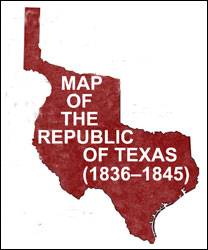 Map of the Republic of Texas. |
|
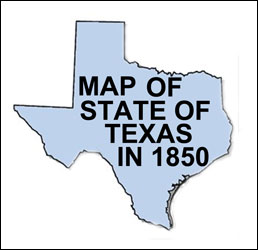 Map of the state of Texas in 1850. |
James Knox Polk—the 11th President of the United States—was born in Mecklenburg County, North Carolina. He later lived in and represented Tennessee. A Democrat, Polk served as the 17th Speaker of the House of Representatives (1835–1839) and governor of Tennessee (1839–1841).
President Polk was a protégé of President Jackson—the Hero of the Battle of New Orleans. President Jefferson purchased Louisiana from France; President Monroe purchased Florida from Spain, and President Polk expected to purchase California from Mexico . . . without a war!!
|
|
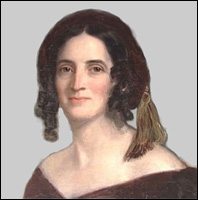
Sarah Polk (1803–1891) devout
Christian spouse and adviser. |
James Knox Polk was determined to be a one-term President, and during that short time he was totally committed to securing the borders of the New Jerusalem. Here are the 3 main geographic goals of his 4-year term:
| 1. |
Secure the Oregon Country for the New Jerusalem. |
| 2.
|
Secure
Texas for the Union. |
| 3.
|
Purchase California from Mexico. |
Like Goliath of Gath challenging El Shaddai and David, Leviathan opposed President Polk with every weapon at his disposal. Here are just 5 in that awesome armory:
| 1. |
The 10-miles-square Infernal Zone filled with despicable spies!! |
| 2. |
Santa Anna and his Mexican army!! |
| 3. |
Leviathan's Pacific Squadron!! |
4. |
The Mormon Battalion!! |
| 5. |
The Hudson's Bay Company!! |
Though victorious in the end, the intense strain cost the President his life, and left his faithful assistant Sarah a grieving widow for the rest of her long life!
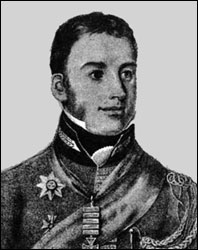 General Edward Pakenham (March 19, 1778–Jan. 8, 1815). |
|
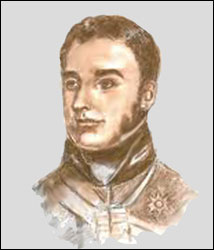
Richard Pakenham (1797–1868).
Amb. from 1835 to 1847. |
Additionally, Pakenham had unlimited funds for bribery from the silver mines in Mexico!
President Polk knew that the annexation of Texas was the casus belli for British controlled Mexico to go to war with the United States. After the annexation of Texas, Mexico broke diplomatic relations with the United States. President Polk did everything in his power to avoid war but Leviathan was determined to annex California not matter what the cost.
President Polk sent Frémont, Stockton, and Gillespie to keep California from Leviathan's jaws!!
President Polk assumed office on March 5,. 1845. Immediately, he prepared to forestall British designs on Oregon and California. On June 1, 1845, he dispatched the famous Pathfinder John C. Frémont to California.
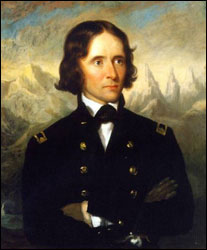 Pathfinder John C. Frémont (1813–1890). |
|
 Christopher "Kit" Carson (1809–1868). |
As the annexation of Texas became a fait accompli, Polk sent 2 more of his most trusted men to California: commodore Robert F. Stockton and U.S. Marine Archibald Gillespie. Commodore Robert F. Stockton—the founder of Liberia—was a devout Christian and a fearless opponent of the British Empire. Stockton believed that Providence had raised up the United States to stop Leviathan from misruling the waves!
At the same time, Polk ordered Archibald Gillespie—a fluent Spanish speaker—to travel overland through Mexico and gauge public opinion as to the likelihood of war with the United States. If Gillespie was arrested in Mexico . . . it would have meant a firing squad!
|
 Archibald Gillespie, USMC (1810–1873). |
Before his departure for Mexico via New York, Gillespie paid a visit to the President and received his final instructions. On October 30, 1845, Polk briefly recorded the interview in his diary:
I held a confidential conversation with Lt. Gillespie of the Marine Corps, about 8:00 o'clock p. m. on the subject of a secret mission on which he was about to go to California. His secret instructions and the letter to Mr. Larkin, U. S. Consul at Monterey, in the Department of State, will explain the object of his mission. (Martin, Messenger of Destiny, p. 8).
Before taking leave of Washington, Gillespie was entrusted with a packet of personal letters from the Thomas Hart Benton family to Captain John C. Frémont, then exploring in California. A brief letter of introduction from Secretary of State Buchanan accompanied the packet. Thus equipped with his instructions, and the papers for Frémont, the young Marine departed for New York to await the sailing of the brig Petersburgh.
So secret were the instructions that Archibald ate them before embarking at Veracruz for the overland journey through Mexico. Gillespie was fluent in Spanish, and his cover was merchant or businessman, as he made a slow journey through Mexico, gauging public opinion from newspapers and Mexican citizens.
Gillespie, Frémont, and Kit Carson were almost scalped in Oregon!!
After a perilous journey overland through Mexico, disguised as a businessman, Archibald finally arrived at the home of U.S. consul Thomas O. Larkin in April 1846.
All the reports of his trip through Mexico confirmed President Polk's foreboding that war with Mexico was imminent. After sending back his reports to the President, After sending back his reports to the President, Archibald headed north to rendezvous with Captain John C. Frémont.
|
Here is a report of that attack from the autobiography of Kit Carson:
He (Fremont) sat up till twelve or one o'clock reading the letters which he had received from the States. Owens and myself were lying near the fire, rolled in our saddle blankets, the night being cold. Shortly after Frémont lay down I heard a noise like the stroke of an axe. Jumping up, I saw that there were Indians in the camp, and gave the alarm. They had already tomahawked two men, Basil Lajenesse and a Delaware, and were advancing to the fire, where four Delawares were sleeping. They heard the alarm in time, and one of them named Crane got up and seized a gun. Unfortunately it was not his own gun and was not loaded. He did not know this, and kept standing erect trying to fire. He fell with five arrows in his breast, four of the wounds proving mortal. (Kit Carson's Autobiography, (pp. 96-97).
When the morning light came, they saw the tomahawks made in England, and distributed to the native Americans by the Hudson's Bay Company:
All night we lay behind our blanket defences, with our rifles cocked in our hands, expecting momentarily another attack, until the morning light enabled us to see that the Indians had disappeared. By their tracks we found that fifteen or twenty Klamaths had attacked us. It. was a sorrowful sight that met our eyes in the gray of the morning. Three of our men had been killed: Basil, Crane, and the half-breed Denny, and another Delaware had been wounded; one-fourth of our number. The chief who had been killed was recognized to be the same Indian who had given Lieutenant Gillespie a salmon at the outlet of the lake. Hung to his wrist was an English half-axe. Carson seized this and knocked his head to pieces with it, and one of the Delawes, Sagundai, scalped him. He was left where he fell. In his quiver were forty arrows; as Carson said, "the most beautiful and warlike arrows he had ever seen." We saw more of them afterward. These arrows all headed with a lancet-like piece of iron or steel—–probably obtained from the Hudson's Bay Company's traders on the Umpqua—and were poisoned for about six inches. They could be driven that depth into a pine tree. (Frémont, Memoirs of My Life, pp. 491-492).
After their miraculous escape from the agents of the Hudson's Bay Company, the little party acted precipitously, and headed south to California. Frémont, Carson, and the U.S. settlers initiated the short-lived Bear Flag Revolution until the U.S. flag was hoisted over Monterey in July.
John C. Frémont was the perfect man for that crucial time in world history. His decisive and impulsive nature came from his Virginia mother and his brains came from his French father.
Admiral Seymour arrived 9 days too late to seize California!!
Just off the coast of California, the Hudson's Bay Company fleet hovered, eagerly awaiting an opportunity to seize California while the United States was distracted by the Mexican war. It was commanded by Lord of the Admiralty board Sir George Seymour:
When war with Mexico came, it was bound to involve California's Pacific coast. Moreover, if the ongoing Oregon boundary dispute with England should come to a head, the U.S. Pacific squadron (330 guns) would be fighting against serious odds, for Britain's largest peacetime fleet (fifteen vessels with 360 guns) patrolled the coast from Oregon to Mexico. The importance of the Pacific coast to England could be measured by the social rank of its Pacific squadron officers: Captain John Gordon, the brother of British foreign secretary Lord Aberdeen, was captain of HMS America, and Lieutenant William Peel, the son of prime minister Sir Robert Peel, was his second-in-command. Furthermore, there was no match to the flagship of the squadron, HMS Collingwood armed with eighty guns and commanded by lord of the admiralty board Sir George Seymour. (Brockmann, Commodore Robert F. Stockton, Protean Man for a Protean Nation, p. 162).
This operation was no side show as the Hudson's Bay Company was going for the GOLD:
Rear Admiral Sir George Francis Seymour was a veteran of Nelson's navy, a deck sailor from the age of 10. Both he and his father, also an admiral, had served on Nelson's flagship, HMS Victory; another admiral of the same vintage was Collingwood, to whom Seymour's own flagship and painted figurehead was a fighting memorial. Seymour took a pension at 28 with face wounds from French grapeshot, going ashore as an aide to King William IV and as a Lord of the Admiralty Board. He had served during the Anglo-American war of 1812, like the senior American officers who faced him on the Pacific in 1846. The experience and wisdom of a respected man as relatively "young" as 57 meant his recall to sea in 1844 to take up the sensitive Pacific command. He read, reflected, watched people and was intellectually inquisitive about the world around him. Physical fitness allowed him to swim ashore from Collingwood off the Mexican coast and take a five-day trek inland to see a silver mine. His landed aristocratic family had included the 16th century Queen Jane Seymour, third and favorite wife of Henry VIII (Tudor) and mother of the boy King Edward VI, Henry's only male issue. (Fox, Macnamara's Irish Colony and the United States Taking of California, p. 125).
The Seymours engineered the downfall and beheading of Anne Boleyn in order to return England to Papal Roma.
 Lord Palmerston (1784–1865). |
|
 Admiral Sir George Seymour (1787–1870). |
The Seymour family always considered themselves the legitimate heirs to the English throne, and California gold would have helped place a Jacobite on the throne once again!
Just 9 days before the British fleet landed, commodore Stockton raised the Stars and Stripes at Monterey.
Commodore Stockton raised the American flag at Monterey on July 7. Sir George Seymour arrived on July 16. He missed seizing California by 9 days:
As HMS Collingwood rounded the peninsula sheltering Monterey Harbor from the Pacific, Point Pinos, Admiral Seymour appeared on deck, according to subordinates, and manifested a great deal of anxiety, and gave orders to the Quartermaster, who carried the spyglass, to keep a sharp lookout when rounding the Point. As the "Collingwood" made the turn and was sailing in, the Admiral, in sharp tones, said, "Quartermaster, do you see a flag flying on shore?" The latter replied, "Yes, sir; but I cannot make it out, sir." The Admiral, becoming more excited, kept repeating the question sharply, and received the same answer. At last he said again, "Quartermaster, do you see a flag on shore now?" The Quartermaster, shading his eyes, and stooping a little, and getting a clearer view under the fog, replied, "Yes, sir; I see a flag very clearly, sir." "What flag is it?" asked the Admiral. The Quartermaster replied, "It is the American flag, sir." Upon which the British Admiral slapped his thigh, stamped his foot and passionately exclaimed in disappointment, "Then, by God, I am too late!" (Brockmann, Commodore Robert F. Stockton, Protean Man for a Protean Nation, p. 170).
Among the Collingwood's passengers was none other than an Irish Jesuit priest named Father Eugene Macnamara, carrying a letter signed by governor Pío de Jesús Pico, granting him permission to colonize California with thousands of Irish fleeing from the potato famine!
| |
|
After the Collingswood landed in Monterey, Macnamara went straight to U.S. consul Thomas O. Larkin and showed him the land grant from governor Pío de Jesús Pico.
|
|
|
|
Larkin told him that he was too late, and the land grant was worthless, now that California was part of the United States:
Mr Macnamara informed me that the Governor and Legislature gave him a deed for 3,000 square leagues of land dated 4, July 1846, he engaging to introduce into California 10 thousand Irishmen, and he applied to me for my opinion of his rights now our flag was over California. I replied that a Governor of California had no power to grant over eleven leagues in a single deed. This act shows a new feature in British policy to obtain a title to California, although Mr Macnamara informed me that he was commissioned by a private company in London. (Fox, Macnamara's Irish Colony and the United States Taking of California, pp. 155-156).
When his California dreamin turned into a nightmare, Macnamara returned to Mexico City, and tried to entice Irishmen to desert from the U.S. Army with promises of free land in California!! Like Judas Riley, nobody knows when he went to meet his Maker.
General Kearny and the British Mormon Battalion!!
Seymour was still hopeful that general Kearny and his 2 spies in the U.S. Navy would yet deliver California into his hands.
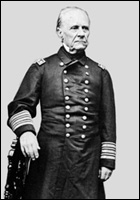 Commodore William Shubrick (1790–1874). |
|
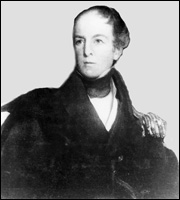 Commodore James Biddle (1783–1848). |
Commodore Shubrick replaced commodore Stockton as commander of all naval forces in the Pacific. Shubrick also appointed general Kearny as military governor of California. When Kearny had enough Mormons at his disposal, he charged colonel Frémont with insubordination.
James Biddle was the brother of Nicholas–president of the Second Bank of the United States–and a deadly opponent of President Jackson.
Bidde was behind the court martial of colonel Frémont. He couldn't arrest commodore Stockton, but he did use the trial of colonel Frémont as an excuse to get him out of California and back to Washington City.
When Palmerson heard the news he was enraged....It was another failure like New Orleans....Britain had lost the opportunity to seize the most valuable real estate on the face of the earth....Immediately, he began to plan the U.S. Civil War, and he was prime minister during that awful conflict.
In May 1846, a West Point graduate named Stephen Watts Kearny was ordered by Secretary of War Marcy to raise an army for the purpose of seizing New Mexico for the United States.
General Kearny was a British spy . . . and his real purpose was to raise an army of Mormons . . . and seize California for the British
|
|
|
|
The Mormon spies were mostly recruited in England and sent to the U.S. to found "Zion" in the wilderness. Their cover was Church of Jesus Christ of Latter Day "Saints." Mormonism was just a religious scam and fraud to seize California and its gold for the British Empire. .
Recruiting for the Mormon Battalion began in June 1846, when general Kearny was authorized to enlist 500 Mormon "volunteers" to help secure California for the Union.
|
|
When his Mormon Battalion arrived in California, general Kearny felt strong enough to challenge the authority of commodore Stockton and colonel Frémont. Commodore Stockton had made Frémont governor of California. Frémont was faithfully carrying out his duties as the new governor when he was arrested by Kearny and his Mormons.
15 Mormons brought John C. Frémont back to Washington City in chains!!
General Kearny, the Mormons, and the Hudson's Bay Company were indeed sore losers. The legendary Pathfinder–who saved California for the United States–was arrested and sent back to Washington City for a court-martial:
Mon., May to, Pueblo de Los Angeles. General Kearny inspected the battalion in the morning. After inspection they closed ranks and the general made a few remarks, thanking them for their good behavior and work. He also asked the single men to reenlist. Fifteen men were detailed to accompany him (Kearny) to Fort Leavenworth as guards for John C. Frémont, who was to be court-martialed for not obeying military directives in California. (Ricketts, The Mormon Battalion, p. 151),
Kearny could not arrest commodore Stockton, but he did advise him to return overland to Washington City for the court-martial of his friend colonel Frémont. On the way back, commodore Stockton was almost scalped by Indians:
General Kearney and his party, though travelling nearly on the line of Stockton's return-route, met scarcely any Indians; while, during the whole journey of the Commodore, his party was almost constantly in the presence of Indians more or less numerous. One of the oldest among the Rocky Mountain hunters in the party said that, as often as he had travelled the route, he had never before seen so many Indians or found them so troublesome and dangerous.
The party was frequently surrounded by bands of Indians immensely superior,. and often placed in the utmost jeopardy. From this peril they were several times rescued by the presence of mind, courage, and sagacity, of Stockton. (Bayard, Commodore Robert F. Stockton: An American Naval Hero, p. 160).
The kangaroo court was packed with "U.S." generals on the HBC payroll....They wanted President Polk to defend Frémont and admit that he sent him to California to seize the territory. President Polk would not take the bait, so they found colonel Frémont GUILTY of insubordination and dismissed him from the Army. Frémont was later PARDONED by President Polk but the stress of the trial caused the couple to lose their newborn baby.
The battle to keep California a free soil state was bitter . . . and deadly!!
Gold was "discovered" in California in January 1848, and California was admitted to the Union as a free soil state in September 1850. After his court martial trial, John C. Frémont returned to California, and he was a zealous opponent of slavery in the Golden State.
|
|
|
|
The battle to keep slaves out of California was intense. John C. Frémont was elected one of two U.S. senators from California. He only served for 175 days. The other senator was the pro-slavery William M. Gwin who served until 1855.
Another zealous opponent of slavery was David C. Broderick–the third U.S. senator from California. Broderick blocked Gwin from being re-elected U.S. senator in 1855. Gwin was out for revenge, and he had one of his friends, judge David S. Terry, challenge Broderick to a duel.
|
|
|
|
A new type of pistol, with a hair trigger, was selected for the duel. Broderick was not familiar with that weapon, and thus fired too quickly:
On learning about the time and location, James J. Ayers drove a horsedrawn carriage most of the night to get there. The place was mobbed. He counted seventy-three spectators. Two sets of weapons had been brought to the dueling grounds. Terry won the toss and selected the ones his side had provided: Belgian-made eight-inch barrels, with hair triggers. Terry had practiced with these pistols, Broderick had not.
The hair trigger proved deadly to Broderick. He was a skilled marksman, practiced regularly, and could handle any pistol that necessitated a quick, firm pull. But a pistol that necessitated a light touch was beyond him. He thus fired too quickly, and his shot went wildly into the ground. The judge's pistol worked perfectly. He took careful aim and shot Broderick in the lung.
Broderick died three days later. His followers never regarded the duel as just a duel. To them it amounted to an assassination. The Chivs, as they saw it, were out to get Broderick, and if judge Terry hadn't pulled the trigger, someone else would have. Declared the Republican Edward Dickinson Baker, at Broderick's funeral service: "His death was a political necessity, poorly veiled beneath the guise of a private quarrel ... What was his public crime? The answer is in his own words: "I die because I was opposed to a corrupt administration and the extension of slavery."' (Richards, The California Gold Rush and the Coming of the Civil War, p. 6).
After Terry killed senator Broderick, he went on to fight for the rebels during the Civil War.
California gold financed the Union armies!!
The miraculous discovery of gold in California in 1848 forever barred the British from seizing the land because people began to arrive from all over the world. Previously, the Mexican government required conversion to the Latin Church before a license was issued to live in the province.
There would be no California dreamin for the Papal Irish . . . or the British Mormons!!
California gold not only enriched the world economy but the also financed the Union during the Civil War:
The two belligerent, however, were far more interested in California gold than in California regiments. Transporting thousands of raw recruits to the East Coast was deemed too expensive, while transporting gold paid handsome dividends. On each steamer sailing out of the Golden Gate, an average of over $1 million in gold went east. Usually, two or three steamers left per month during the four years of the war.
Several times the gold shipments ran over $2 million per steamer, and on one occasion over $3 million. The high point came in 1864, when over $46 million in gold was sent via Panama to support the North's credit and help arm, feed, and clothe one million Union fighting men. Noted General Ulysses S. Grant: "I do not know what we would do in this great national emergency were it not for the gold sent from California." (Richards, The California Gold Rush and the Coming of the Civil War, pp. 229-230).
This was the same General Useless Grant who said in his Memoirs that the Mexican war was "the most unjust war ever waged by a stronger against a weaker nation."
The communications revolution began during the Presidency of Polk!!
On May 24, 1844, Professor Samuel Morse sent the first message via electricity from Washington City to Baltimore .It comprised the short Biblical phrase: What Hath God Wrought!
The next transmission announced that James Knox Polk was the Democratic candidate for President of the United States.
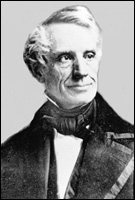
Samuel F.B. Morse
(1791–1872). |
|
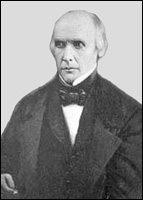
Cave Johnson (1793–1866).
Postmaster General from '45 to '49. |
Morse saw the telegraph as a natural adjunct to the Post Office. President Polk was very enthusiastic about the telegraph but was powerless to act without the approval of Congress.
Morse was willing to sell his patent to the Post Office for the measly sum of $100,000. Cave Johnson convinced Congress that Morse was a magician or sorcerer, and the government refused to fund the greatest invention since the printing press.
Private industry was left to develop the telegraph and this led to competition and feuds among the various companies. Today, GCHQ and NSA use the very latest technology to spy on the whole world.
Securing the New Jerusalem's borders killed President Polk
For 4 long years, without a single vacation, President Polk and Sarah labored to secure the borders of the young Republic. Washington City was a HORRIBLE location for the capital and the weather was unbearably hot in the summertime. The politicians could leave in the summertime . . . but not the President and his small staff.
Even the man President Polk sent to Mexico to negotiate a peace treaty turned out to be a British spy. His name was Nicholas P. Trist and he asked the British ambassador, Charles Bankhead, for "advise" about the new boundaries.
|

By 1849 the New Jerusalem's borders
extended from sea to shining sea. |
President Polk's 4 short years in the White House took a terrible toll on his health. Even his assistant Sarah was frequently ill. The south side of the White House overlooked the Potomac and a canal laden with malaria-carrying mosquitoes. Quinine was available, but there was a high incidence of malaria among those who stayed in the Infernal Zone during the hot season and exposed themselves to infection.
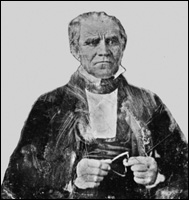 President Polk in 1849. |
|
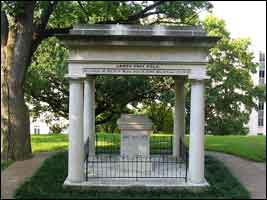 James K. Polk's tomb lies on the grounds of the state capitol in Nashville, Tennessee. |
The Polks kept the Sabbath Day holy and did not allow any kind of business to take place in the White House on the Lord's Day. That is why the New Jerusalem had such spectacular victories over its foreign and domestic enemies:
If you refrain from trampling the Sabbath underfoot, from doing thy pleasure on my holy day; and call the Sabbath a delight, the holy of JEHOVAH, honourable; and shalt honour him, not doing thine own ways, nor finding thine own pleasure, nor speaking thine own words: Then shalt thou delight thyself in JEHOVAH; and I will cause thee to ride upon the high places of the earth, and feed thee with the heritage of Jacob thy father: for the mouth of JEHOVAH hath spoken it (Isaiah 58:13-14).
The true story of the conquest of California would make a great Hollywood epic with a guarantee of winning at least 10 Academy Awards!
Vital links
References
Bayard, Samuel. Commodore Robert F. Stockton: An American Naval Hero. Derby & Jackson, New York, 1856.
Borneman. Walter R. Polk: The Man Who Transformed the Presidency. Random House, New York, 2008.
Bumgarner, John Reed. Sarah Childress Polk. A Biography of the Remarkable First Lady. McFarland & Co., Publishers, Jefferson, North Carolina, 1997.
Brockmann, R. John. Commodore Robert F. Stockton: Protean Man for a Protean Nation. Cambria Press, Amherst, New York, 2009.
Chaffin, Tom. Pathfinder: John Charles Fremont and the Course of American Empire. Farrar, Straus & Giroux, New York, 2002.
Carson, Kit. Kit Carson's Autobiography. University of Nebraska Press, Lincoln, Nebraska, 1966. (First published in 1856).
Dillon, Richard. Fool's Gold: The Decline and Fall of Captain John Sutter of California. Coward-McCann, New York, 1967.
Drexler, Robert W. Guilty of Making Peace: A Biography of Nicholas P. Trist. University Press of America, Lanham, Maryland, 1991.
Frémont John Charles. Memoirs of My Life. Cooper Square Press, New York, 2001. (First published in 1886).
Fox, John. Macnamara's Irish Colony and the United States Taking of California in 1846. McFarland & Co., Pub., Jefferson, North Carolina, and London. 2000.
Hague, Harlan, & Langum, David J. Thomas O. Larkin: A Life of Patriotism and Profit in Old California. University of Oklahoma Press, Norman, OK, 1990.
Locke, Audrey A. The Seymour Family. Houghton Mifflin Co., Boston, 1914.
Larkin, Thomas O. A Life of Patriotism and Profit in Old California. University of Oklahoma Press, Norman, 1978.
Marshall, Thomas Maitland. History of the Western Boundary of the Louisiana Purchase, 1819–1841. University of California Press, Berkeley, 1914.
Marti Werner H. Messenger of Destiny: The California Adventures, 1846–1847 of Archibald H. Gillespie. John Howell Books, San Francisco, California, 1960.
Nevin, David. Dream West. Tom Doherty Associates, New York, 1983.
Ridley, Jasper. Lord Palmerston, E.P. Dutton, New York, 1971.
Ricketts, Norma Baldwin. The Mormon Battalion: U.S. Army of the West 1846–1848. Utah State University Press, Logan, Utah, 1996.
Roberts, David. A Newer World: Kit Carson, John C. Frémont, and the Claiming of the American West. Simon & Schuster, New York, 2000.
Salomon, Calos Manuel. Pío Pico: the Last Governor of Mexican California. University of Oklahoma Press, Norman, OK, 2010..
Roberts, David. Devil's Gate: Brigham Young and the Great Mormon Handcart Tragedy. Simon & Schuster, New York, 2008.
Sherwood, Midge, Frémont: Eagle of the West. Jackson Peak Publishers, North Hollywood, California, 2002.
Stone, Irving. Immortal Wife: The Biographical Novel of Jesse Benton Frémont. Doubleday & Sons, Garden City, New York, 1944.
Stein, Mark. How the States Got Their Shapes. HarperCollins Publishers, New York, 2008.
Copyright © 2022 by Patrick Scrivener

